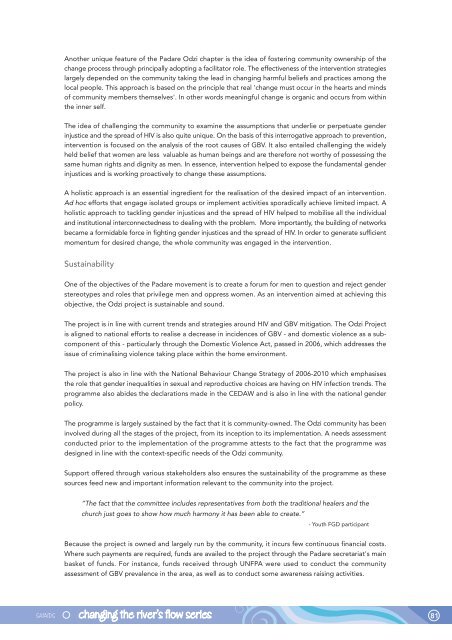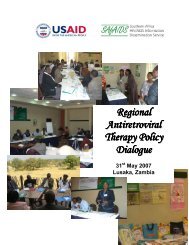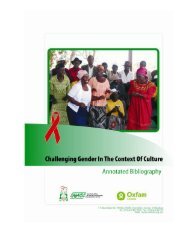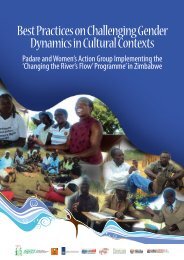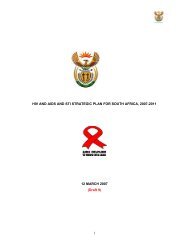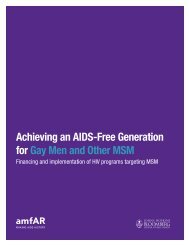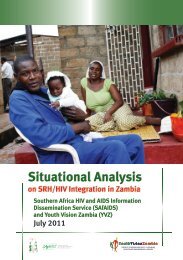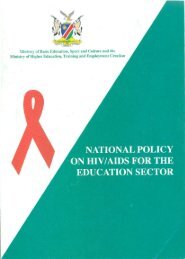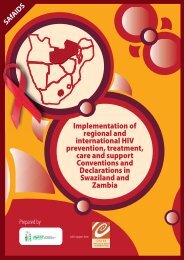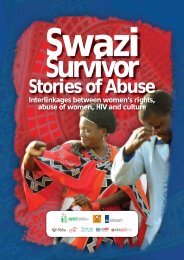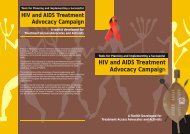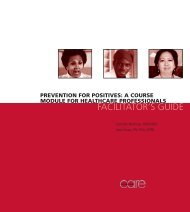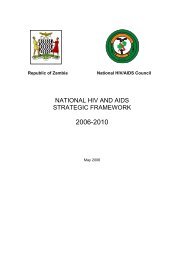Zimbabwean stories of "Best Practice" - SAfAIDS
Zimbabwean stories of "Best Practice" - SAfAIDS
Zimbabwean stories of "Best Practice" - SAfAIDS
You also want an ePaper? Increase the reach of your titles
YUMPU automatically turns print PDFs into web optimized ePapers that Google loves.
Another unique feature <strong>of</strong> the Padare Odzi chapter is the idea <strong>of</strong> fostering community ownership <strong>of</strong> thechange process through principally adopting a facilitator role. The effectiveness <strong>of</strong> the intervention strategieslargely depended on the community taking the lead in changing harmful beliefs and practices among thelocal people. This approach is based on the principle that real 'change must occur in the hearts and minds<strong>of</strong> community members themselves'. In other words meaningful change is organic and occurs from withinthe inner self.The idea <strong>of</strong> challenging the community to examine the assumptions that underlie or perpetuate genderinjustice and the spread <strong>of</strong> HIV is also quite unique. On the basis <strong>of</strong> this interrogative approach to prevention,intervention is focused on the analysis <strong>of</strong> the root causes <strong>of</strong> GBV. It also entailed challenging the widelyheld belief that women are less valuable as human beings and are therefore not worthy <strong>of</strong> possessing thesame human rights and dignity as men. In essence, intervention helped to expose the fundamental genderinjustices and is working proactively to change these assumptions.A holistic approach is an essential ingredient for the realisation <strong>of</strong> the desired impact <strong>of</strong> an intervention.Ad hoc efforts that engage isolated groups or implement activities sporadically achieve limited impact. Aholistic approach to tackling gender injustices and the spread <strong>of</strong> HIV helped to mobilise all the individualand institutional interconnectedness to dealing with the problem. More importantly, the building <strong>of</strong> networksbecame a formidable force in fighting gender injustices and the spread <strong>of</strong> HIV. In order to generate sufficientmomentum for desired change, the whole community was engaged in the intervention.SustainabilityOne <strong>of</strong> the objectives <strong>of</strong> the Padare movement is to create a forum for men to question and reject genderstereotypes and roles that privilege men and oppress women. As an intervention aimed at achieving thisobjective, the Odzi project is sustainable and sound.The project is in line with current trends and strategies around HIV and GBV mitigation. The Odzi Projectis aligned to national efforts to realise a decrease in incidences <strong>of</strong> GBV - and domestic violence as a subcomponent<strong>of</strong> this - particularly through the Domestic Violence Act, passed in 2006, which addresses theissue <strong>of</strong> criminalising violence taking place within the home environment.The project is also in line with the National Behaviour Change Strategy <strong>of</strong> 2006-2010 which emphasisesthe role that gender inequalities in sexual and reproductive choices are having on HIV infection trends. Theprogramme also abides the declarations made in the CEDAW and is also in line with the national genderpolicy.The programme is largely sustained by the fact that it is community-owned. The Odzi community has beeninvolved during all the stages <strong>of</strong> the project, from its inception to its implementation. A needs assessmentconducted prior to the implementation <strong>of</strong> the programme attests to the fact that the programme wasdesigned in line with the context-specific needs <strong>of</strong> the Odzi community.Support <strong>of</strong>fered through various stakeholders also ensures the sustainability <strong>of</strong> the programme as thesesources feed new and important information relevant to the community into the project.“The fact that the committee includes representatives from both the traditional healers and thechurch just goes to show how much harmony it has been able to create.”- Youth FGD participantBecause the project is owned and largely run by the community, it incurs few continuous financial costs.Where such payments are required, funds are availed to the project through the Padare secretariat's mainbasket <strong>of</strong> funds. For instance, funds received through UNFPA were used to conduct the communityassessment <strong>of</strong> GBV prevalence in the area, as well as to conduct some awareness raising activities.81


